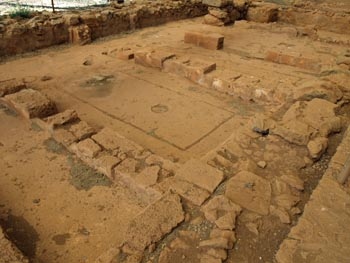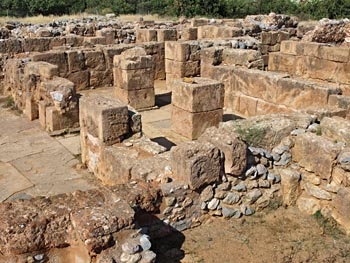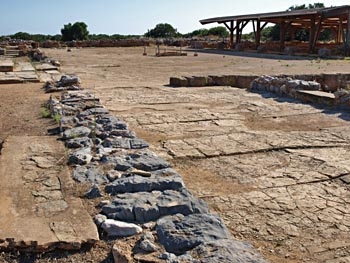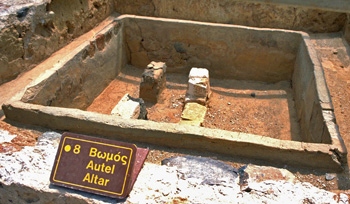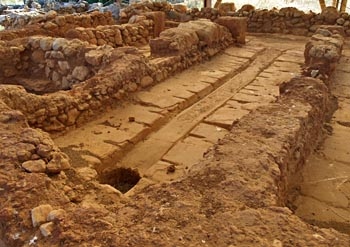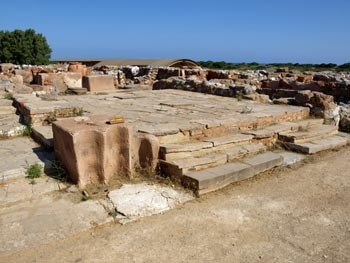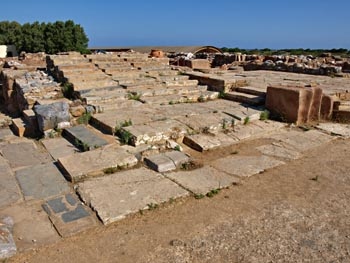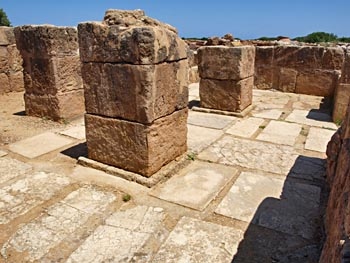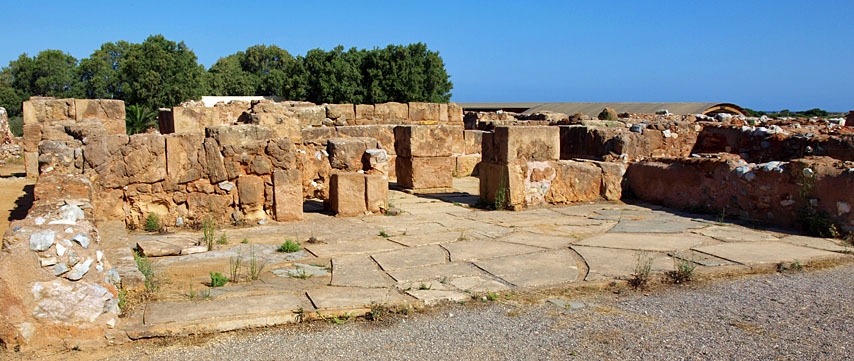
Location
The Palace of Malia is situated on the North coast of Crete, East of Heraklion. To the south lie the Lasithi mountains. At 7,500 square metres, it is the third largest of the Minoan palaces. The Minoan name for the Palace is not known and it takes its name from a local town.
It is now thought that the first monumental architecture to be erected on the Malia site dates back to EM IIB. An EM IIB building, or possibly a group of buildings, built around a large open space has been discovered below the present Palace, and aligned in the same way. Below this EM IIB building are the remains of EM IIA architecture built in a more simple style and based on a different orientation.
In the view of Jan Driessen, the EM II building or buildings would not have been a Palace like the ones that emerged later but would have been more like a monumentalised court, the beginning of a process of bringing ritual in from the natural environment to a closed, artificially constructed environment.
Already in the pre-palatial period the town had grown to occupy an area of 2.58 hectares, with remains of the town found beneath the Palace and to the north west. Some of the walls in the West magazines of the Palace had been constructed in EM II and incorporated into the new structures when the first palace was built, where they remained standing until the final destruction of the Palace. When these walls were first excavated, Vasiliki ware pottery (from EM II) was found in a foundation deposit.
The old palace -- when was it built?
The traditional view has always been that the first palaces were constructed in MM IB (around 1900 BCE) at a time when a powerful elite of some sort was emerging on the island. Other indicators of the emergence of this elite were thought to be the growing widespread use of the fast turning potter's wheel, the emergence of local writing scripts and administration, specialised craft production, urbanisation and long-distance trade, especially in metal. However, it is now thought by some archaeologists that the palaces were in fact begun at different times and there was no sudden shift from a simple pre-palatial era to a suddenly more complex proto-palatial Crete as had first been thought.
At Malia, remains of EM III-MM IA buildings appear to represent a town or small city considerably larger than anything that existed before. The population at Malia must have been counted in the thousands. Excavators have uncovered EMIII-MMIA remains throughout the area but the neopalatial palace may have covered up most of the remains on the site of the palace itself. Some archaeologists now claim that the first palace was begun in EM III-MM IA but the excavators of the site disagree strongly about the issue. Van Effenderre has denied that there was a palace at Malia at this early date, while O. Pelon claims to have found not only traces of an EMIII-MMIA palace but evidence for an ever earlier EM II predecessor. Jean-Claude Poursat, who excavated Quartier Mu, says there isn't enough evidence to be sure either way.
The evidence for an early date is very limited. Pelon bases his view on two discoveries. Firstly a "teapot" of Patrikies type was found inside a stone enclosure at the base of a palatial wall. Secondly in the northwest quarter of the palace he found some EM III-MM IA sherds along with the MM II floor deposit. While it seemed logical to date the destruction to MM II Pelon assumed that the earlier material meant the first palace had been constructed over the course of MM IA. This would make it possibly the first palace to be built on Crete, although it has been argued that similar EM II monumental architecture also existed at Knossos, which may affect the dating of the first palace there.
However, Jean-Claude Poursat argues that the high point of the early development at Malia was EM IIB and that during EM III there was so little activity that it was almost as if the site had been abandoned. In the town only a single deposit has been dated to EM III, and while reoccupation is clearly underway in MM IA, it is not clear how extensive this activity was. A group of buildings called maisons sud, part of which are to be found underneath the palace, seem to date from MM IA. Given that the palace was built over part of these houses, Poursat argues that the palace cannot have been constructed before the very end of MM IA at the very earliest and possibly in MM IB. Indeed, Poursat believes that there is so little evidence of activity at Malia in EM III/MM IA when compared with Knossos and Phaistos, where construction works were undertaken throughout this period, that it is surprising that Malia was able to build a palace at all at the same time as Knossos and Phaistos.
Indeed, Poursat goes even further. He argues that between 2300 and 1900 (EM III/MM IA), Malia was no more developed than other sites like Gournia, Vasiliki and Petras at that time and he asks how it was possible for Malia to achieve the same level of construction as Phaistos and Knossos so quickly. Moreover, suddenly the whole area is inhabited. A period of massive construction work produces new areas of Malia town, with large buildings seemingly independent of the palace and with their own style of architecture. He suggests the answer for the rapid rise of a local elite may lie in the two main activities carried out in Quartier Mu, one of the more impressive areas of the Middle Minoan town: bronze working and textile production.
There does not seem to be much room for agreement between those who argue for an early date for the construction of the first palace and those who believe that it dates from the same period as the other two palaces built at Knossos and Phaistos. The dispute is only likely to be resolved if further evidence can be found to support one or other of the two positions.
Little is known of the Old Palace though some finds from the Old Palace period attest to the wealth of the Old Palace at Malia. This palace was later destroyed, along with the surrounding town, at the end of MM IIB, probably by an earthquake.
The new palace
The second palace, the ruins of which we see today, was built about 1650 BCE and is similar in many respects to the old one. The second palace was destroyed around 1450 BCE, along with the other Minoan sites in Crete. The various functions of a palace -- religious, political, economic -- are all in evidence here.
For over 60 years, excavators at Malia have concluded that Malia palace was a vassal of Knossos. The power of Knossos grows during EM III and it extends the territory under its control. It dominates international trade.
During MM III there is little rebuilding work done at Malia although the palace continued to function. There is evidence of craft activity, trade and administration being carried out in the palace. It is as if operations formerly carried out in the town in areas like Quartier Mu, which was never rebuilt, have been brought into the Palace itself. Some archaeologists believe that Malia may have maintained its independence up until 1600 BCE.
The new palace is essentially constructed in LM IA in the Knossian style and this suggests that Malia may now have passed into the control of the elite at Knossos. Much that would be expected is missing in LM IA Malia. Status objects are few, there are no administrative documents either in the palace or the town, pottery styles are influenced by Knossos and frescoes seem to be almost non-existent. Poursat wonders if the rebuilding of Malia was a plan by Knossos to ensure access to the east end of the island. The palace declined in LM IB when it was finally destroyed along with most other Minoan centres on Crete.
A tour of the Palace
The first attempt to excavate the site was made in 1915 by Joseph Hadzidakis but the full excavation of the Palace and much of the surrounding town was conducted by the French Archaeological School under F. Chapouthier and is still continuing today. Like the other palaces Malia has a west court. The west wing of the Palace, which probably had two storeys, contained magazines, cult rooms and official apartments.
To the east is the Central Court, which existed at the time of the Old Palace. This central court is oriented north-south and the main entrance to the court would have been from the north. The central court measures 48 metres by 23 metres. The north and west sides of the Central Court were lined by porticoes, a common feature in Minoan Palace architecture. Often the pillars would be alternately wood and stone, a feature also to be seen at the Knossos palace.
In the middle of the central court there is an unusual altar which was built in the New Palace period. Inside the sunken area are four supports. Although altars are common enough features of the Palaces and even of palace-like buildings such as the country house at Makriyialos on the south coast, this particular feature is unique to the Malia palace.
To the east of the Central Court are the East Magazines, well-preserved and now covered for protection. The six magazines each consist of a raised area where the pithoi would have been placed, and in the middle of each magazine there is a channel which ends with a hole in the ground. It has been argued that these channels and holes were for collecting any liquids -- wine, olive oil or whatever -- that got spilled.
Opposite the magazines on the north side of the west wing was a large building, in the middle of which was the "Loggia". This building was entered from the Central Court up four steps. It is assumed that religious rites took place here which would have been visible from the central court. Behind the Loggia, and linked to it by a stairway, was the Treasure Room. Other rooms in this part of the Palace included a lustral basin and an assembly room.
To the south of the Loggia is the grand staircase. which originally led to a first floor room. To the left of the grand staircase, steps led south into the corridor which led to the Main Hall, an area used for religious purposes, which stood exactly opposite the Central Court altar. Again the Malia palace follows the traditional design of the palaces, since at Knossos the west side of the central court contained buildings with a religious function, including a tripartite shrine.
The pillar crypt is entered from the Main Hall, and two large pillars can still be seen in the room, one of which has the engraving of a double axe on it. Pillar crypts exist in other palaces and in other buildings as well and their use is assumed to be religious. This view has been challenged but in many of the pillar crypts the room is far too small to need a central pillar to support the roof. An alternative explanation therefore has to be sought for the existence of these pillars in so many Minoan buildings. To the west of this area ran a long corridor, onto which opened a large number of magazines or storerooms. Once again the traditional design of the Minoan Palace is maintained.


